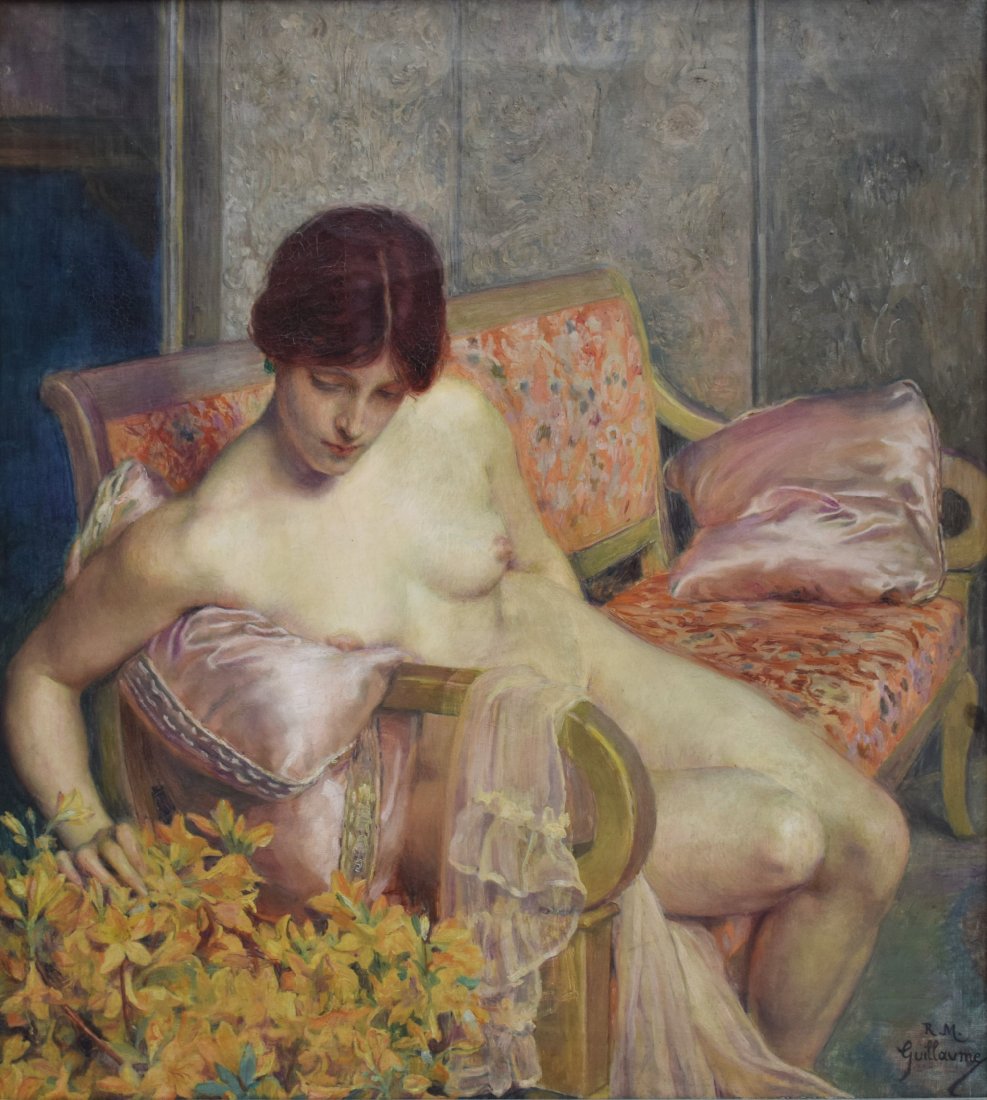Description:
Rose-Marie Guillaume (1876- ?), a representative of French fin de siècle art, was one of the graduates of the Julian Academy in Paris. She was taught by William Adolphe Bougeureau, Jules J. Lefebvre and Tony Robert-Fleury. For a long time, the painter remained unknown by her name and was referred to as “Mademoiselle R.-M. Guillaume” in catalogs. Initially, she exhibited portraits at salons and later female nudes, presented in the scene of “artists’ life”. Her works were awarded and her skill was appreciated.
Description of the painting:
“Flowers” were purchased at one of the Paris shows in 1902. The work is considered to be very good in terms of technique. The painting belongs to the popular academic trend of the early 20th century art. It met the expectations of the French middle class – seemingly innocent, the work presented a naturalistic female nude.
In the picture there is a young woman sitting on a patterned fabric couch. She is nude. Her chestnut hair is carefully done up. Emerald earrings adorn her ears. The softly outlined contours of her body are complemented by the satin pillows decorating the couch. The model is comfortably settled. Her left arm is not visible. Her right hand delicately touches yellow-orange petals of the flowers standing next to her. She seems to be focusing all her attention on them and not noticing the artist observing her.
One of many seemingly everyday scenes taking place in a closed, defined interior becomes a pretext for depicting a female act. The title of the work is ironic. On the one hand, flowers are associated with delicacy, natural beauty and a sense-stimulating scent. However, in the context of the restrictions on artistic education imposed on painters by dozens of years, the title can also be interpreted as a desire to break the socially accepted norms regarding topics more in line with the nature of the female artist.
At the turn of the 19th and 20th centuries, women in the world of art constituted a definite minority. In the earlier period, there was a conviction about their socially assigned leading role of mother and wife. If women were engaged in artistic activities, it was only for the purpose of leisure. They had no access to educational facilities in the field of arts. Only from 1803 in France, they could attend professional schools, which taught drawing, but only for industrial purposes, such as the École nationale du dessin pour les jeunes filles. Such a scope of artistic activity was to be in accordance with their nature, “delicate and distinguished by the ability to imitate”*.
In public opinion, art by women did not carry any splendor with it. Mastering its basics was to have only utilitarian basis, it was a guarantee of “domestic happiness”. The thought of equal competition in the field of art with male painters was interpreted as “threatening to the established social order”*.
In schools available to women, due to prevailing moral norms, they were not allowed to paint or draw “human figures from nature, in particular a study of the act, which is an essential tool of academic composition and work on the most noble, according to contemporary opinion, of the genres – historical painting”. As a result, the predominant themes of their works were landscapes, still lifes and portraits. In 1897, women gained admission to the Paris School of Fine Arts, and from 1903 they could participate in the prestigious Prix de Rome competition. Private schools also met the expectations of future artists. An increasing number of institutions offering contact with eminent painters and exchange of artistic experiences were established*.
In France, Rodolphe Julian opened the gates for representatives of the fair sex with the Academy, founded in 1868. It had the status of a private art school. All its students were educated according to the same standards, regardless of gender or social status. They followed Ingres’s principles, according to which “the basis of the teaching was drawing a naked model from nature”*. The education took place in separate studios: painting, sculpture and drawing. For reasons of decency, Julian abandoned the original idea of co-education and opened separate courses for men and women. The main tasks of the Academy included preparing future art adepts for artistic rivalry*.


